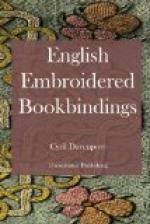The most decorative, and in many ways the finest, of all the remaining embroidered books of the time of Elizabeth is now at the Bodleian Library at Oxford. It is one of the ‘Douce’ Bibles, printed in London in 1583, and probably bound about the same time. It was the property of the Queen herself, and is bound in crimson velvet, measuring 17 by 12 inches. The design is the same on both sides, and consists of a very cleverly arranged scroll of six rose stems, bearing flowers, buds, and leaves springing from a large central rose, with four auxiliary scrolls crossing the corners and intertwining at their ends. The large rose in the centre as well as those near the corners are Tudor roses, the red shown in red silk and the white in silver guimp, both outlined with gold cord. Small green leaves are shown between each of the outer petals. These flowers are heavily and solidly worked in high relief. The smaller flowers are all of silver, the buds, some red, some white. The stems are of thick silver twist enclosed between finer gold cords, and the leaves show a little green silk among the gold cord with which they are outlined and veined. Immediately above and below the centre rose are two little T’s worked in small pearls.
[Illustration: 25—Bible. London, 1583.]
The narrow border round the edges is very pretty; it is a wavy line of gold cord and green silk, the hollows within the curves being filled with alternate ‘Pods’ with pearls, and green leaves. The back is divided into four panels by wavy lines of gold cord and pearls, and the upper and lower panels have small rose-plants with white roses, buds, and leaves; the inner panels have each a large Tudor rose of red and white, with leaves and buds. The drawing and designing of this splendid book are admirable, and the workmanship is in every way excellent. Many of the pearls are gone, and some of the higher portions of the large roses are abraded, the back, as usual, being in a rather bad state; but in spite of all this, and the inevitable fading, the work remains in a sufficiently preserved condition to show that at this period the art of book-embroidery reached its highest decorative point. It is rather curious to note that Henry VIII. used the red Lancastrian rose by preference, but that on Elizabeth’s books the white rose always appears, and I know of very few instances where the red rose appears on her books. Of course both sovereigns used the combined, double, or Tudor rose as well.
[Illustration: 26—The Commonplaces of Peter Martyr. London, 1583.]
The Commonplaces of Peter Martyr. London, 1583.




